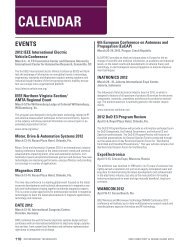2011 EMC Directory & Design Guide - Interference Technology
2011 EMC Directory & Design Guide - Interference Technology
2011 EMC Directory & Design Guide - Interference Technology
You also want an ePaper? Increase the reach of your titles
YUMPU automatically turns print PDFs into web optimized ePapers that Google loves.
standards<br />
O n t h e N at ur e a nd Us e of t h e 1.04 m El e c t ric Fiel d Probe<br />
Just as above, this is the magnitude of the radially directed<br />
field; we desire the vertical component, which is (x≥d/2)<br />
or<br />
Eqn. 5e<br />
Eqn. 6b<br />
Between d/2 (5 cm) and 1.04 meter along the rod antenna,<br />
the electric field from the wire above the ground<br />
plane contributes a potential given by<br />
and (when 0 < x < d/2)<br />
Eqn. 5f<br />
Eqn. 6c<br />
Between 0 and d/2 along the rod antenna, the electric<br />
field from the image wire contributes a potential given by<br />
The potential induced along any curve due to an electric<br />
field impinging upon it is given in general by<br />
Eqn. 6a<br />
where the integral is understood to be a line integral,<br />
with electric field in the direction of the curve at every point<br />
being summed over the length of the curve.<br />
In the case of the rod antenna, we are integrating over its<br />
length, starting at the base and ending at the tip 1.04 meters<br />
above it. We can calculate the potential from the above<br />
ground wire, and then separately calculate the potential due<br />
to the image wire, and then, carefully taking into consideration<br />
the signs, combine the different contributions to arrive<br />
at the net potential induced in the rod. In order to perform<br />
the integration, the various expressions for the electric field<br />
from the above ground wire (equation 5b) and the image wire<br />
(equations 5e when x≥d/2 and equation 5f when 0 < x < d/2)<br />
are substituted for E in equation 6a, and dx substitutes for<br />
dl. Because the vertical components of the electric field are<br />
parallel to the rod, the dot product of equation 6a becomes<br />
a simple scalar multiplication.<br />
In addition to separate expressions for the electric field<br />
from the image wire according to whether x is either less<br />
than or greater than d/2, the signs of the fields must be properly<br />
treated. From 0 to d/2, the contributions from the wire<br />
and its image add because the vertical component of each<br />
field is downwards. Above d/2, the vertical components are<br />
oppositely directed, and they subtract from each other. In<br />
the case of the MIL-STD-461F set up, with part of the rod<br />
below the ground plane, there is a short region below the<br />
ground plane where the field contributions from wire and<br />
image again subtract, but the signs of each contribution are<br />
opposite what they are when x > d/2 above the ground plane.<br />
It is also important to note that the range of integration is not<br />
based on the rod antenna as an absolute, but in relationship<br />
to where the radiating wire is. The radiating wire closest to<br />
the zone of integration is the zero point for integrating. Thus<br />
in some cases we integrate up from some point along the<br />
rod, and down the other direction from that point.<br />
Between 0 and d/2 along the rod antenna, the electric<br />
field from the wire above the ground plane contributes a<br />
potential given by<br />
Eqn. 6d<br />
Between d/2 (5 cm) and 1.04 meter along the rod antenna,<br />
the electric field from the image wire contributes a<br />
potential given by<br />
Integrals of the form<br />
Eqn. 6e<br />
Equation 6b simplifies to<br />
with x running<br />
from 0 to d/2.<br />
Eqn. 6f<br />
Equation 6c simplifies to equation 6f with a change of<br />
sign out front.<br />
with x running from<br />
d/2 to 1.04 meters.<br />
Eqn. 6g<br />
Equation 6d simplifies to<br />
with x running<br />
from 0 to d/2.<br />
Eqn. 6h<br />
Equation 6e simplifies to<br />
with x running from<br />
d/2 to 1.04 meters.<br />
Eqn. 6i<br />
Three problems of interest are the “traditional” or MIL-<br />
STD-461E set-up, MIL-STD-461F, and a variation on the<br />
traditional approach where the antenna electronics box at<br />
the base of the rod sits on top of the counterpoise instead<br />
of below it. We use equations 6f – i to calculate all the various<br />
potentials from the wire above ground and its image.<br />
Then we sum all the contributions. This represents the open<br />
circuit potential between the rod base and tip and also the<br />
effective field intensity. Half this calculated potential is the<br />
open circuit potential on the rod, loaded and then amplified<br />
by the rod antenna base and presented into 50 Ohms.<br />
“Traditional” or MIL-STD-461E calculation - Solve for<br />
the potential on the rod antenna from the radiating wire<br />
when the base of the rod antenna is the same height as the<br />
ground plane, and one meter away (Figure 3a).<br />
72 interference technology emc <strong>Directory</strong> & design guide <strong>2011</strong>


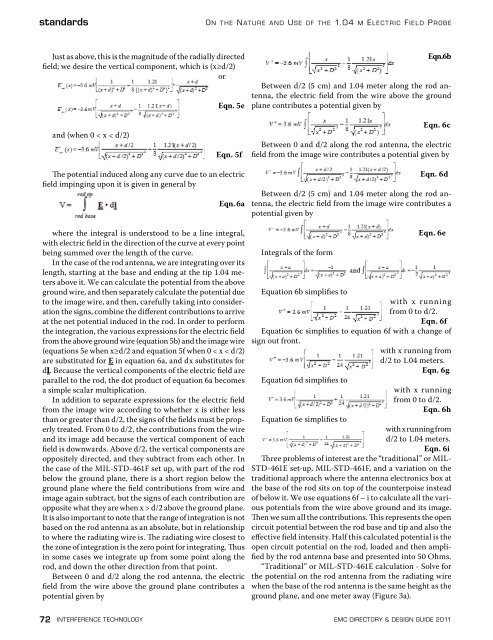

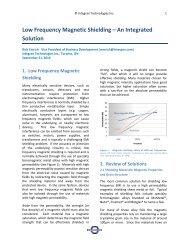

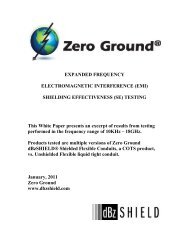
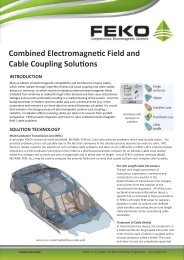



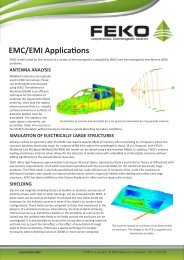
![[ thursday ] morning sessions 8:30 am-noon - Interference Technology](https://img.yumpu.com/23176841/1/190x247/-thursday-morning-sessions-830-am-noon-interference-technology.jpg?quality=85)
